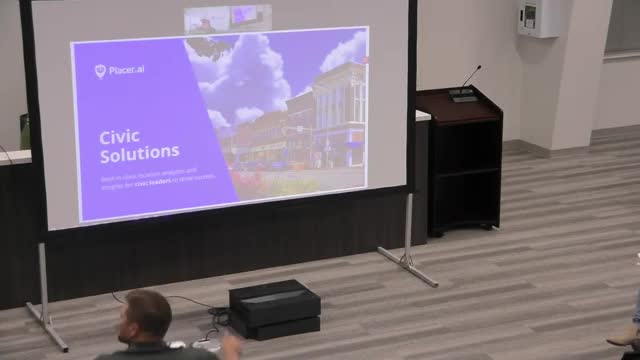Data Revolutionizes Economic Development Strategies in US Cities
October 09, 2024 | Manvel, Brazoria County, Texas
This article was created by AI summarizing key points discussed. AI makes mistakes, so for full details and context, please refer to the video of the full meeting. Please report any errors so we can fix them. Report an error »

In a recent government meeting, officials discussed the utilization of mobile location data to enhance economic development and tourism strategies in their city. The presentation highlighted how data from millions of mobile devices can be aggregated to provide insights into consumer behavior, including where visitors come from, where they work, and their spending habits.
The data analytics firm, Placer, has emerged as a leading provider of such insights, serving over 4,000 clients in various sectors, particularly civic organizations. The company emphasizes a privacy-first approach, ensuring that no personally identifiable information is collected. Instead, the focus is on understanding the movement patterns of mobile devices to inform local economic strategies.
Key applications of the data include supporting local businesses, attracting retailers, and analyzing workforce trends. Officials were shown how to use Placer's platform to access historical data dating back to 2017, allowing them to track foot traffic to specific locations, such as shopping centers and parks. This capability can help cities understand visitor trends and make informed decisions about future developments.
The meeting also covered the importance of identifying \"retail leakage,\" where residents travel outside the city for shopping and services. By analyzing where residents go for amenities, officials can strategize on attracting businesses that meet local demand. For instance, if residents are frequently visiting a nearby city for dining options, this could indicate a gap in the local market that needs to be filled.
Additionally, the presentation included a demonstration of how to conduct a \"void analysis\" to identify the best potential tenants for vacant commercial spaces. By comparing demographic data and consumer demand, cities can make strategic decisions about which businesses to attract, ensuring they align with community needs and preferences.
Overall, the meeting underscored the potential of leveraging mobile location data to drive economic growth and improve local services, positioning the city to better compete in attracting both residents and businesses.
The data analytics firm, Placer, has emerged as a leading provider of such insights, serving over 4,000 clients in various sectors, particularly civic organizations. The company emphasizes a privacy-first approach, ensuring that no personally identifiable information is collected. Instead, the focus is on understanding the movement patterns of mobile devices to inform local economic strategies.
Key applications of the data include supporting local businesses, attracting retailers, and analyzing workforce trends. Officials were shown how to use Placer's platform to access historical data dating back to 2017, allowing them to track foot traffic to specific locations, such as shopping centers and parks. This capability can help cities understand visitor trends and make informed decisions about future developments.
The meeting also covered the importance of identifying \"retail leakage,\" where residents travel outside the city for shopping and services. By analyzing where residents go for amenities, officials can strategize on attracting businesses that meet local demand. For instance, if residents are frequently visiting a nearby city for dining options, this could indicate a gap in the local market that needs to be filled.
Additionally, the presentation included a demonstration of how to conduct a \"void analysis\" to identify the best potential tenants for vacant commercial spaces. By comparing demographic data and consumer demand, cities can make strategic decisions about which businesses to attract, ensuring they align with community needs and preferences.
Overall, the meeting underscored the potential of leveraging mobile location data to drive economic growth and improve local services, positioning the city to better compete in attracting both residents and businesses.
View full meeting
This article is based on a recent meeting—watch the full video and explore the complete transcript for deeper insights into the discussion.
View full meeting
